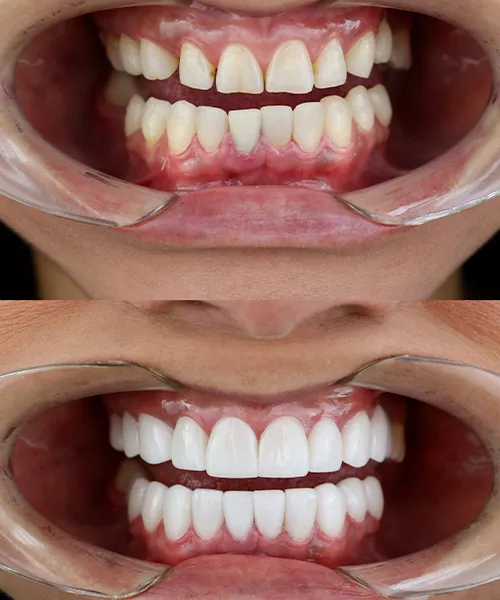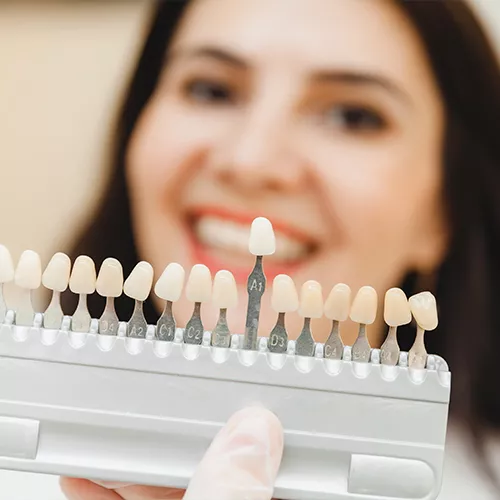Complete guide to dental veneers: a perfect smile within reach
Modern aesthetic dentistry offers various methods to improve your smile and achieve perfect-looking teeth. One of the most popular and effective methods is dental veneers. This comprehensive guide covers everything you need to know about veneers – what they are, who they are suitable for, how they are applied, the different types available, how to care for them, and what to expect in terms of cost.
What Are Dental Veneers?
Dental veneers, also known as tooth veneers, are thin aesthetic shells made of composite material or porcelain that are applied to the front surface of teeth. Their purpose is to conceal imperfections such as discoloration, shape irregularities, or misalignment, creating a visually perfect and naturally looking smile. Despite being extremely thin, veneers are strong and durable, providing long-lasting results.

Who Are Veneers Suitable For?
Veneers are a great option for a wide range of people looking to enhance their smile. They are particularly ideal for patients with:
- Unevenly colored teeth – Veneers can effectively cover stains and discoloration caused by smoking, coffee consumption, or natural aging.
- Damaged teeth – Small cracks, chips, or worn-down teeth can be easily concealed with veneers.
- Gaps between teeth – Veneers are a great solution for those who have gaps between their front teeth and want a more even appearance.
- Irregularly shaped teeth – If your teeth are unevenly shaped or vary in length, veneers can help create a harmonious, balanced smile.
- Slightly misaligned teeth – Veneers can partially correct minor misalignment without the need for orthodontic treatment.
No-Prep Veneers
At our dental clinic, we also offer no-prep veneers. Unlike traditional veneers, they require little to no tooth reduction or enamel removal, making them a less invasive alternative.
The main difference between traditional veneers and no-prep veneers lies in tooth preparation and the invasiveness of the procedure:
Traditional Veneers
Tooth Preparation: Requires the removal of a certain amount of enamel from the front of the tooth to make space for the veneer. This process can be slightly uncomfortable and often requires local anesthesia.
Invasiveness: More invasive, as it involves grinding down a healthy part of the tooth.
Suitability: Ideal for patients who need significant adjustments in tooth shape, size, or color.
No-Prep Veneers
Tooth Preparation: Requires no enamel removal or only minimal preparation. The veneers are extremely thin and applied directly to the tooth surface.
Invasiveness: Less invasive, preserving more of the natural tooth structure. The procedure is typically pain-free and often doesn’t require anesthesia.
Suitability: Perfect for patients who need minor aesthetic improvements, such as color enhancement or slight shape corrections.
Both types of veneers have their advantages and disadvantages. The choice between them depends on the individual needs of the patient and the recommendation of the dentist.
The Principle of Dental Veneers
Dental veneers work on the principle of thin shells that are bonded to the front surface of the teeth. Thanks to the material and precise craftsmanship, veneers not only cover imperfections but also look very natural and blend seamlessly with the surrounding teeth. Veneers are commonly used to correct aesthetic concerns such as unevenness, unwanted gaps, or damage—without the need for complex and lengthy procedures.
How to Prepare for Veneers
The preparation for applying veneers includes several basic steps:
- Consultation with a Specialist – During the initial visit, the dentist evaluates the condition of your teeth and discusses your goals. Based on your needs and expectations, the dentist will recommend the type of veneers that is most suitable for you.
- Design and Planning – The dentist prepares a design of how your veneers could look, including selecting the appropriate shade to ensure the veneers naturally match your smile.
- Tooth Preparation – This step involves gently removing a very thin layer of enamel to ensure the veneers adhere securely to the teeth. This process is minimally invasive, and for certain types of veneers, it can even be skipped entirely.
- Veneer Fabrication – After taking dental impressions, the dentist sends them to a dental lab where your custom veneers are created. This process usually takes a few days.
How Are Veneers Applied?
Applying veneers is a relatively simple and painless process. Once the veneers are ready and the dentist confirms they fit perfectly, the application begins. The steps are as follows:
- Fit and Color Check – The dentist places the veneers on your teeth to ensure they fit correctly and match the desired appearance.
- Adhesive Application – After checking the fit and color, a special dental adhesive is applied to the tooth to ensure the veneer bonds securely.
- Bonding the Veneer – The veneer is carefully placed on the tooth, and the dentist uses a special light to harden the adhesive quickly.
How Long Do Veneers Last?
Veneers typically last between 10 to 15 years, depending on the material used and how well they are maintained. Porcelain veneers tend to last longer than composite ones, as they are more durable and resistant to stains. With proper oral hygiene and regular dental check-ups, veneers can last even longer.
Types and Materials of Dental Veneers
There are two main types of veneers, each with different characteristics and advantages:
- Porcelain Veneers – These veneers are stain-resistant, have a natural shine, and closely mimic the look of natural teeth. They are usually more expensive but also longer-lasting.
- Composite Veneers – Made from composite resin, these veneers are more affordable than porcelain. Their benefits include a shorter preparation time and lower cost, but they are less durable and may not look as natural as porcelain veneers.

Veneer Maintenance
Veneers do not require any special care, but the following is recommended:
- Regular Cleaning – It’s important to clean veneers just like natural teeth. Brushing, flossing, and using a suitable toothpaste will help maintain their appearance.
- Avoid Hard Foods – Biting into hard items like candies or nuts can increase the risk of chipping a veneer.
- Limit Colored Beverages – Drinks like coffee, tea, and red wine can stain veneers over time.
What Are the Risks of Getting Veneers?
Veneers are generally considered a safe and effective procedure, but there are some potential risks:
- Tooth Sensitivity – After enamel reduction, teeth may become more sensitive to temperature and certain foods.
- Irreversibility – Since enamel must be removed, the process is irreversible. Once veneers are applied, they cannot be removed without replacement.
- Risk of Detachment – In some cases, veneers can detach, especially if the teeth are exposed to hard objects.
How Much Do Veneers Cost?
The cost of veneers varies depending on the material, the number of veneers needed, and the clinic's location. The average price for one porcelain veneer can range from 10,000 CZK to 15,000 CZK. Composite veneers are usually more affordable. The total cost for a full set of veneers can be significant, but many patients consider it a worthwhile investment for long-term satisfaction with their smile.
Summary
Dental veneers offer an elegant solution for those who desire a perfect smile. Whether you choose porcelain or composite veneers, the result is an aesthetically pleasing and confident smile that lasts for years. A consultation with a specialist is essential to choose the most suitable type of veneers and ensure a long-lasting effect that boosts both satisfaction and self-confidence.
Our Clinic’s Equipment
Experience 21st-Century Aesthetic Dentistry
At Clinic for Smile, you are cared for not only by highly trained specialists but also with the most advanced dental technology, including a 3D X-ray and an intraoral scanner.
Additionally, there’s no need to worry about excessive pain. When necessary, we use local anesthesia to make your procedure as comfortable as possible. Visit Clinic for Smile and experience 21st-century aesthetic dentistry.
Let us take care of you.
Your Reviews





